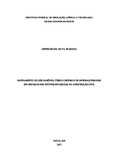Mapeamento do gás radônio, tório e urânio e de minerais pesados em areias do Rio Potengi-RN usadas na construção civil

Visualizar/
Data
2017-08-30Autor
Souza, Ozenildo Gil Silva de
http://lattes.cnpq.br/4659520233912300
Metadado
Mostrar registro completoResumo
One of the least noticeable environmental impacts is that of natural radioactive elements,
problems that are directly related to the accidents that occur in nuclear plants or related to the
destination of the so-called atomic waste, which are the residues from radioactive materials
such as uranium for the fission of the atom, in addition to problems caused by radioactive
elements from natural sources and which can cause the contraction of cancerous diseases
caused by the contact of humans with these elements, mainly uranium, thorium, radium and
radon. The present dissertation aims at mapping the natural radiation of radon, thorium and
uranium gas and heavy minerals in the Potengi-RN river sands used in construction. The
methodology used is based on field techniques to measure the natural radiation of the PotengiRN
river sands with the use of equipment such as the RS-125 and RS-220 spectrometer range
and laboratory procedures to map the levels of radon gas in the sands the use of the electret
ionization camera method, as well as laboratory techniques to characterize the heavy minerals
of the dry bed sands of the Potengi-RN river, such as X-ray Dispersive Energy (EDX)
detection techniques, Dispersive Energy by Spectroscopy (EDS) and Scanning Electron
Microscopy (MEV). The results show different radioactive concentrations from the presence
of uranium, thorium, potassium and radon elements, with the highest concentrations being
related to mechanized mineral extraction and, in particular, proximity to rocky outcrops along
the river. In addition, some heavy minerals were identified in the sands of the dry river bed, in
particular the Rare Earth Elements (ETR). It is concluded, therefore, that the techniques used
were important in the mapping of radioactive elements and heavy minerals in the river sands
and that, even with low concentration of radon gas, any exposure to this gas is detrimental to
health regardless of its levels of concentration; in terms of heavy minerals the highlight is for
the identification of ETRs in alluvial sandy minerals. Thus, the use of the Potengi-RN river
sands in the construction industry should be given special attention by the regulatory and
oversight bodies to monitor the contents of the radioactive elements and heavy minerals in
these sands, since they may be a risk factor for the population.



